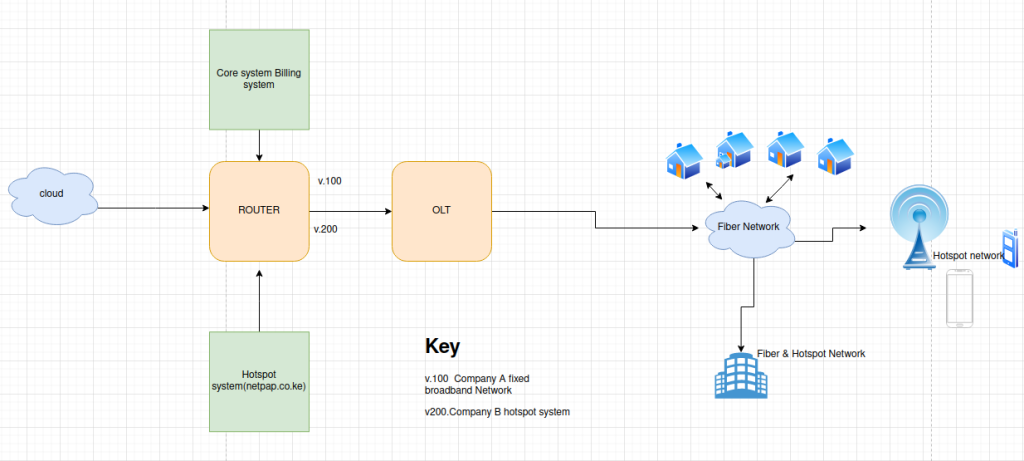- 1.INTRODUCTION
- 1.1. Background
- 1.2. Purpose
- 2.0 UNDERSTANDING HVNO
- 2.1. What is HVNO?
- 2.2. HVNO vs. Traditional Hotspot Networks
- 2.3. Benefits of HVNO
- 3.1. Virtualization Technology
- 3.2. Captive Portal
- 3.3. Mesh Network
- 3.3. Hotspot Billing
- Deployment and Implementation
- 4.1. HVNO Architecture
- Use Cases and Applications
- 5.1. New Customer Segments
- Challenges and Solutions
- 6.1. Security and Privacy
- 6.2. Conflict of Interest
- 6.3. Scale of Preference
- Future Trends
- 7.1. Cross-Selling
- Conclusion
1.INTRODUCTION #
1.0:A block representation of an Hotspot virtual Network Operator

1.1. Background #
The telecommunications industry continually evolves, driven by the insatiable demand for high-speed, reliable connectivity. The advent of fiber networks, wireless last-mile connectivity, and cheap broadband have necessitated a diversification of services. Hotspot Virtual Network Operators(HVNO) emerged as an innovative business model to bridge the digital divide. This white paper explores HVNO, its components, applications, challenges, and future trends.
1.2. Purpose #
This white paper aims to provide an in-depth understanding of HVNO, its significance in the modern telecommunications landscape, and its potential to expand access to bandwidth.
2.0 UNDERSTANDING HVNO #
2.1. What is HVNO? #
Hotspot Virtual Network Operator(HVNO) is a business model in which a network operator without core infrastructure sells hotspot services through leased infrastructure. Ideally, a third-party company or a company’s department would propose to run a hotspot on the core infrastructure over VLANs. The hotspot would then be accessible in all fiber-ready locations. Customer premise equipment would then be configured to broadcast the hotspot in bridge mode. Such networks can then be extended with media converters and access points. Noteworthy, due to isolated VLANs, the hotspot does not interfere with the core network.
2.2. HVNO vs. Traditional Hotspot Networks #
In traditional hotspot networks, there is heavy investment in infrastructure and sufficient low-cost bandwidth. HVNO, on the other hand, allows infrastructure to be shared through virtualization without extraordinary capEX.
2.3. Benefits of HVNO #
- Resource Efficiency: HVNO maximizes resource utilization. It ensures that IPT networks can utilize idle bandwidth for hotspot customers.
- Scalability: HVNO allows the operator to scale rapidly in areas where the fiber network is already available, and customer acquisitions are faster with a noticeable brand or solid initial presence.
- Cost Savings: Minimal initial cost of investment
- Key Components of HVNO
3.1. Virtualization Technology #
Network virtualization plays a vital role in HVNO. They enable the creation of virtual network functions and network slices. An independent network is created at the edge router available to the rest of the network for hotspot access.
3.2. Captive Portal #
Devices like Mikrotik allow the development and customization of captive portals so that end users can interact with network packages and offerings.
3.3. Mesh Network #
Mesh networks offer connectivity by grouping devices into one network within a small geographic location. It allows customers to be signed in to the network and access the internet.
3.3. Hotspot Billing #
Netpap’s Hotspot Billing platform offers advanced carrier-level functionalities to allow operators to provide affordable and flexible packages with automated billing using available mobile wallets. Netpap has operated for seven years and transacts thousands of vouchers daily.
Deployment and Implementation #
4.1. HVNO Architecture #
HVNO architecture consists of a hotspot provisioned in a core router and transmitted through a VLAN. The hotspot is deployed side by side to a pole aggregator or can be provided in a separate router. The ONUs or the customer-premise equipment are configured in bridge mode. It allows the hotspot to be operational. The network coverage can be extended using suitable and meshed access points. Users can then make purchases via the captive portal on their handheld devices.
Use Cases and Applications #
5.1. New Customer Segments #
Different market segments can be reached. Customers unwilling to pay for a fixed subscription will use this offering. Customers who stay on the premises for a short time will opt for this new offering.
Challenges and Solutions #
6.1. Security and Privacy #
As an HVNO is deployed, security and privacy concerns become paramount. Therefore, robust virtualization, access control management, and security policies are essential to mitigate these risks. A legal framework and mode of operation also need to be operationalized.
6.2. Conflict of Interest #
Hotspot network operators may opt to span multiple fiber networks, which may cause friction and concerns about interest. It can be well covered in a legal framework to guide engagements.
6.3. Scale of Preference #
A large carrier provider may decide to deploy the hotspot solution, but the revenues may not be as optimal and recurrent as a fixed broadband segment. It may discourage some carriers from undertaking the solution. Opening the business to lease agreements under this model may mitigate that. A pre-agreed revenue-sharing model may ensure the needs of every party are taken care of.
Future Trends #
7.1. Cross-Selling #
HVNO, with scale, can open hotspot e-commerce, a solution where the landing page can be used for e-commerce, video streaming, and Wi-Fi advertising. It would open a new revenue stream for the stakeholders.
Conclusion #
Hotspot Virtual Network Optimization (HVNO) represents a significant step forward in diversification and development. As the demand for high-quality connectivity continues to grow, HVNO will play a pivotal role in shaping the future of telecommunications.



